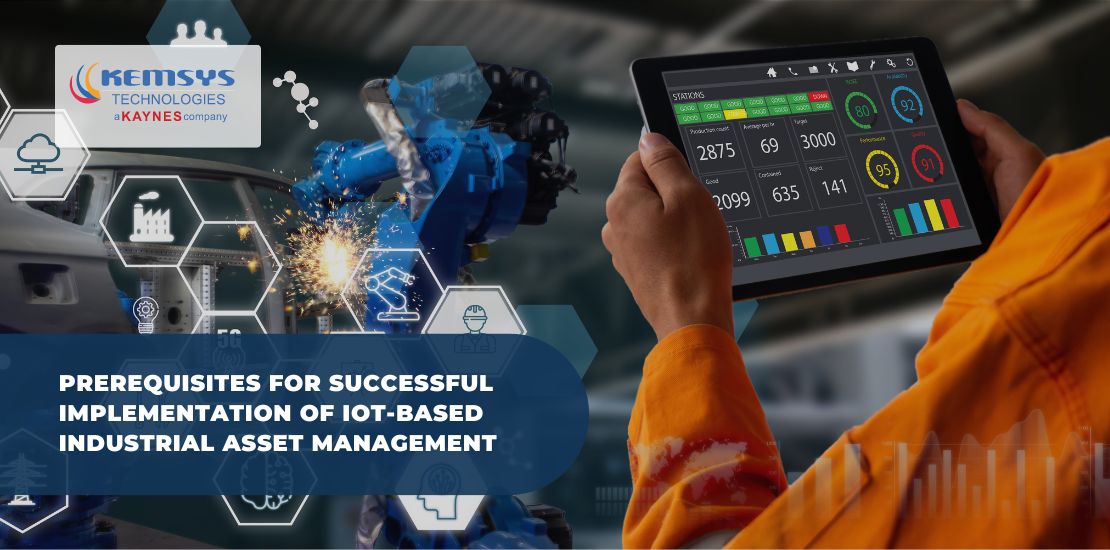Prerequisites for Successful Implementation of IoT-based Industrial Asset Management
- June 19, 2024
- Posted by: Sanket Pathak
- Category: Industrial Asset Management

Adopting IoT-based industrial asset management is an inevitable transformative step for any organization. According to Statista, the global market for industrial Internet of Things (IIoT) was sized at over 544 billion U.S. dollars in 2022. The market is expected to grow in size in the coming years, reaching some 3.3 trillion U.S. dollars by 2030. Most industries have realized the way forward cannot be forged without adopting appropriate technology.
IoT-based Asset Management promises enhanced operational efficiency, reduced downtime, and data-driven decision-making. However, successful implementation is dependent upon meticulous planning and preparation. However, there are certain prerequisites that organizations need to consider before they can fully embrace IoT-based industrial asset management. Let’s discuss some of these prerequisites.
1. Current Asset Assessment
- Before implementing IoT-based asset management, organizations must comprehensively assess their current assets. This assessment may include everything from machinery, equipment, vehicles, and infrastructure to any other kind of physical assets.
- Create a centralized database of all assets, including details like make, model, serial number, location, and current status among other details.
- Assess the current condition of assets to determine their suitability and compatibility for IoT integration.
- Inspect the equipment for wear and tear, performance issues, and potential upgrade requirements. Understanding the condition of assets helps prioritize the deployment, focusing on critical assets first.
- Conduct physical inspections, review maintenance records, and use diagnostic tools to evaluate asset health. Gathering historical performance data establishes baseline metrics for future comparison.
According to Deloitte, companies that conduct thorough asset assessments before IoT implementation see a 20% increase in operational efficiency post-adoption.
2. Defining Clear Objectives and Strategies
- Define what the organization aims to achieve with the implementation. Clear goals provide direction and help us to prioritize efforts.
- Involve stakeholders from different departments to identify key objectives, align them with overall business goals, and document them.
- Define relevant KPIs, such as equipment uptime, maintenance costs, energy consumption, and operational efficiency, and set realistic targets for each.
McKinsey highlights that companies with well-defined objectives see a 30% higher ROI on IoT investments.
3. Integration with Current Systems
This is one of the most critical prerequisites for a successful IoT asset management adoption. Seamless integration with existing systems is essential for maximizing the benefits of IoT. Compatibility issues can lead to data silos and inefficiencies.
- Conduct a thorough compatibility assessment.
- Identify potential integration challenges.
- Work with vendors to resolve them.
Integrated data streams enable comprehensive analysis, uncovering insights that drive operational improvements and strategic decisions.
Forrester Research indicates that 60% of IoT projects fail at the integration stage, emphasizing the need for thorough planning.
4. Selecting the Right IoT Platform or Partner
Choosing the appropriate IoT platform or partner is critical. For any business, it is important to evaluate the partner and their offerings.
- Evaluate platforms based on their ability to handle data analytics, scalability, and security features.
- Select partners with proven experience in industrial IoT implementations and a strong support structure.
- A robust IoT asset management platform will always ensure reliability, scalability, and security, which are essential for a successful implementation.
The expertise and support of the vendor can significantly impact the success of IoT projects.
According to IDC, organizations that carefully select their IoT platform see a 40% improvement in implementation success rates.
Read Our Case Study: IoT Asset Tracking
5. Training and Skill Development
Empowering employees with the necessary skills to manage IoT systems is vital. You cannot drive the future without equipping the people with the required knowledge.
Well-trained employees can maximize the benefits of IoT systems, ensuring smooth operation and quick resolution of issues.
- Create training materials
- Conduct workshops
- Hands-on training sessions
- Ongoing skill development programs
This will ensure that your team remains capable and competitive.
A survey by Capgemini found that companies investing in IoT training for their workforce achieve 25% higher productivity gains.
6. Suitable IoT Sensors and Devices
Selecting the right IoT sensors and devices is crucial for accurate data collection. Choose sensors that meet the specific requirements of the assets being monitored.
- Choose sensors that meet specific requirements.
- Opt for durable and can withstand the harsh operational environment.
- Proven long-term reliability, which will reduce the need for frequent replacements.
Statista reports that the revenue from the IoT sensors market was over $27 billion in 2022 and is forecasted to increase to about $43 billion by 2025.
7. Change Management and Cybersecurity
Managing change and ensuring cybersecurity are critical for IoT success.
Develop a change management strategy to ensure smooth adoption of IoT technologies. It helps address resistance, align stakeholders, and ensure successful implementation.
- Effective change management ensures stakeholder buy-in, minimizes disruption, and facilitates a smooth transition to IoT systems.
- Communicate the benefits of IoT, involve key stakeholders in the planning process, and provide support throughout the transition.
- Implement robust cybersecurity measures to protect IoT systems from cyber threats. IoT devices can be vulnerable to attacks, making cybersecurity a top priority for any IoT system.
- Implement encryption, access control, regular security audits, and incident response plans to safeguard IoT systems.
According to Palo Alto Networks, 98% of all IoT device traffic is unencrypted, highlighting the need for strong cybersecurity measures.
8. Secure Data Management and Analytics Platform
Effective data management and analytics are essential for deriving actionable insights. For any organization adopting IoT asset management needs secure and scalable data storage solutions. IoT systems generate vast amounts of data that need to be stored securely and accessed efficiently.
- Secure and scalable storage ensures data integrity and availability, enabling effective analysis and decision-making. Choose data storage solutions that offer scalability, redundancy, and robust security features, such as encryption and access controls.
- Effective analytics enable data-driven decision-making, improving operational efficiency and asset management. Evaluate different analytics platforms, consider their capabilities and integration options, and select tools that meet your analytical needs.
According to a report by IBM, effective data management and analytics can lead to a 20% increase in operational efficiency.
9. Regulatory Compliance
Ensuring compliance with relevant regulations is essential for avoiding legal challenges. Make sure that compliance is met with industry-specific regulations and standards. Non-compliance can result in fines, legal actions, and reputational damage.
- Stay updated on relevant regulations.
- Implement compliance monitoring tools.
- Conduct regular audits.
- Ensure that your IoT systems comply with data privacy regulations such as GDPR and CCPA.
Data privacy is critical for protecting sensitive information and maintaining user trust.
A study by Deloitte found that regulatory compliance is a top concern for 67% of organizations adopting IoT technologies.
10. Robust Network Infrastructure
A reliable network infrastructure is the backbone of any IoT asset management system.
- Implement redundant network paths to ensure continuous connectivity. Redundancy protects against network failures, ensuring reliable IoT operations.
- Design your network architecture with redundant paths, use fallback mechanisms, and regularly test network resilience.
- Network failures can disrupt IoT systems, leading to data loss and operational inefficiencies.
- Ensure sufficient bandwidth to handle the data load from IoT devices. Assess current bandwidth usage, upgrade network infrastructure if necessary, and implement bandwidth management tools.
Cisco estimates that robust network infrastructure reduces IoT downtime by 40%.
11. Pilot Testing & Evaluation
Conducting pilot tests helps identify potential issues before full-scale implementation.
- It’s best to start with an implementation on a small scale to test functionality and integration. Pilots provide valuable insights into how IoT systems perform in real-world conditions.
- Pilot testing minimizes risks by identifying and addressing issues early, ensuring smoother full-scale implementation. Select a representative sample of assets or processes for the pilot, define clear evaluation criteria, and monitor performance closely.
- Monitor the performance of IoT systems during the pilot phase and gather feedback. This involves collecting data on system reliability, data accuracy, and user satisfaction.
- Performance evaluation helps refine IoT solutions, ensuring they meet operational requirements and deliver expected benefits.
- Analyze pilot data, identify areas for improvement, and make necessary adjustments before full-scale deployment.
Accenture reports that organizations conducting pilot tests before full deployment experience a 30% reduction in implementation risks.
Conclusion
Adopting IoT-based industrial asset management requires a multifaceted approach involving careful planning, infrastructure readiness, and continuous improvement. Companies can ensure successful implementation and optimal outcomes by addressing the prerequisites outlined in this article.
Learn more about IoT asset management systems and how to leverage asset management to elevate your business to the next level. Contact us to speak to our team of experts and know how we can enable your asset management journey.

